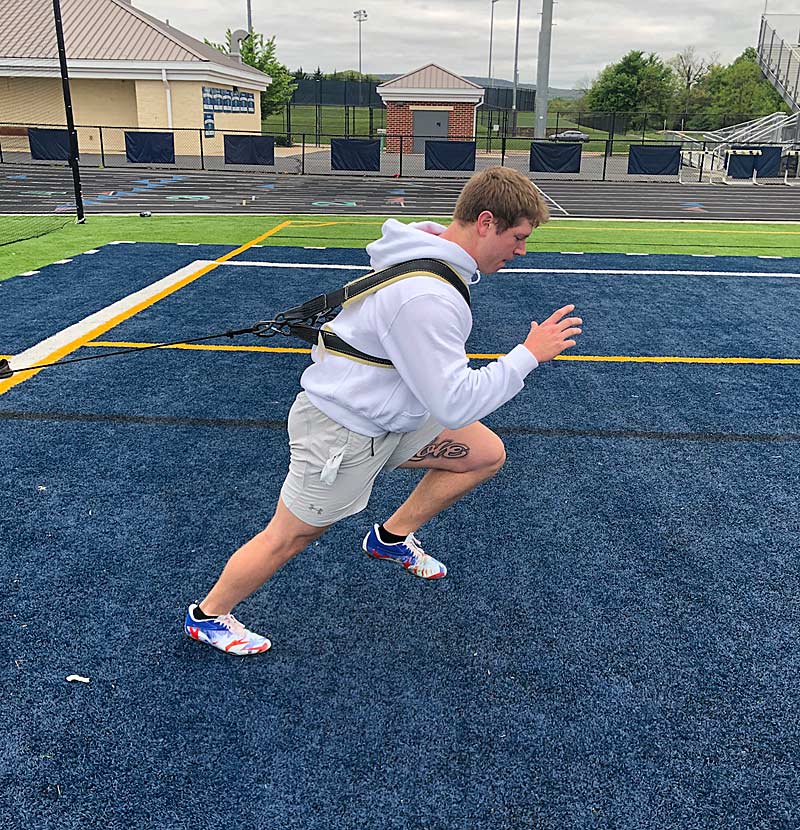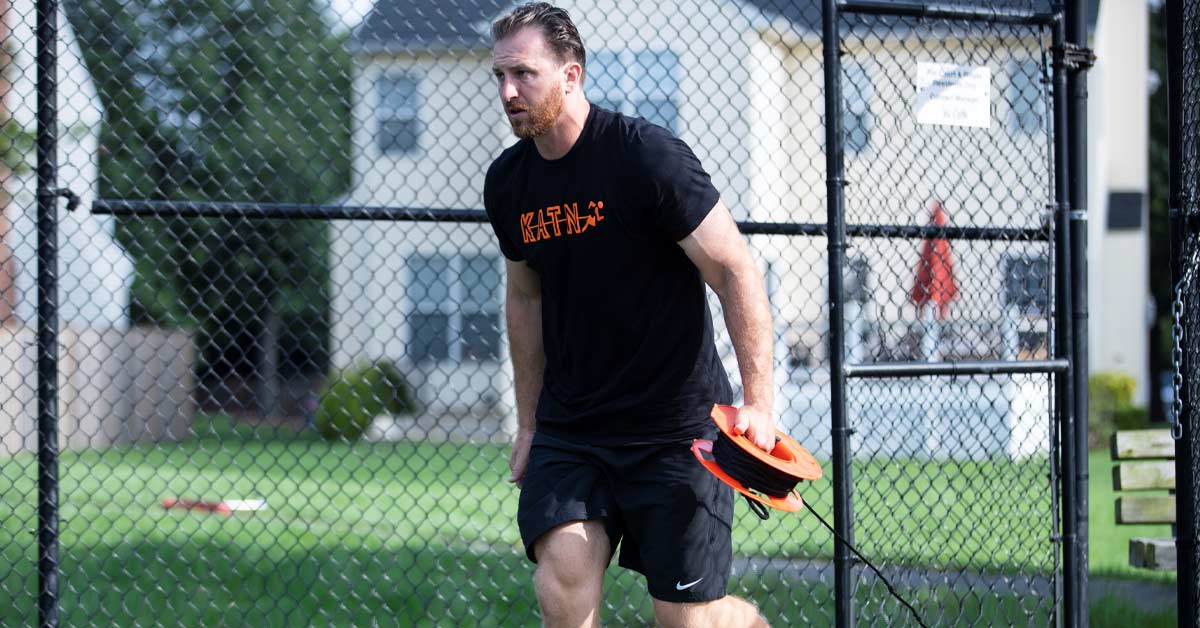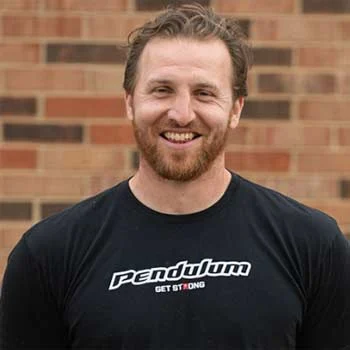Maintaining progress is hard. Not only are there different protocols to help athletes achieve their goals, but athletes respond differently to the protocols—especially in sprint training. During my playing career, the most common advice I received was: “If you want to get fast, run fast.”
While true, this type of thinking will only take an athlete or coach so far. After improving for a time, the athlete will inevitably reach a training plateau, which may be caused by suboptimal technique, a lack of joint stiffness, or general strength. At this point, the training focus needs to be clarified. This clarification often comes with an increased specificity, whether through drill selection or coaching cues. These drills and cues are often derived from the teachings of elite sprint coaches who train sprinters and can then be insufficient for field sports athletes who, generally speaking, have different body types or experience levels when compared to a traditional sprinter. If the drills and cues are not effective for some athletes, how do we help them continue to progress when they have seemingly leveled out?
If the drills and cues are not effective for some athletes, how do we help them continue to progress when they have seemingly leveled out? Share on XOne way is to apply a horizontal load to the athlete with a weighted sled or tools like the Run Rocket, Vertimax Raptor, or KATN Strength Engine, which can provide external feedback that makes the cues more effective, manage the athlete’s technical deficiencies, lack of coordination, or deficient strength qualities.
Technical Proficiency
Field sport athletes are not required to master sprinting technique to become better at their sport. However, a proficiency can be helpful in achieving higher velocities, which if relevant, can increase sports performance. More importantly, proficient sprinting, when prescribed effectively, exposes the athlete to high rates of force development and higher contractile velocities which can be helpful in preventing injuries.
Now the question becomes how do you start developing proficiency when you are tasked with introducing the athlete to positions that they are not familiar with? Often, the coach is forced to rely on external verbal or tactile cues to encourage the athlete to find the correct positions, i.e., “Push harder into the ground” or “Keep the foot dorsiflexed.”
During my 10 year NFL career, I was coached by dozens of coaches and experienced firsthand the frustration with being unable to improve past a certain point based solely based on the coach-provided cues. And, as a coach in my post-playing career, I now understand the frustration from the other side: you feel you are communicating clearly, but the athlete is still unable to internalize the cue (thus, stunting the athlete’s progress).
One way to circumvent the language barrier—and in my experience the most effective—is to help the athlete feel the position associated with the cue. This allows the athlete and the coach to speak the same language—especially because athletes tend to be kinesthetic learners.
One way to circumvent the language barrier—and in my experience the most effective—is to help the athlete feel the position associated with the cue. Share on XThe question then becomes what is the best way to allow the athlete to feel the position? Isometrics, yielding or overcoming, are tools that not only help the athlete coordinate their position but also help with joint- and angle-specific motor unit recruitment and rate coding (the rate at which the motor unit discharges action potentials).
Perhaps the most common isometric exercise for sprinting are wall drills, which are often used to reinforce the position and tension required during the acceleration phase. While these exercises are outstanding, they can fall short. Often, young athletes get so infatuated with the wall they leave their hips behind, let their chest collapse, or lose postural integrity. One way to get a similar effect is to anchor the athlete from behind like they are pulling a sled—I use the KATN Strength Engine for this, but an anchored chain or cord would also work.
This technique differs from traditional wall drills in that the athlete is held from the back with a cord connected to a belt or chest harness. This different modality allows the athlete not only to feel the correct angle and tension, like a wall drill, but also forces them to stabilize through the hip and midsection in a way that is specific to sprinting. When prescribing this to new athletes, it is often helpful to have them use a dowel or a hurdle to help with balance.

These exercises are also fantastic because they don’t require a lot of space. At the end of most college or professional workouts, there is the required midsection work. Often coaches program anti-rotation exercises like Pallof presses. Now, the Palloff press is an outstanding exercise, but why not use this opportunity to program single leg isometric holds and help your athletes get acclimated to positions relevant to sprinting while working midsection strength?
Once these foundational positions have been established, the athlete can move on to dynamic exercises such as heavy marches or sled pushes. These next exercises allow the athlete to work dynamically through sprint-relevant positions that have been coached isometrically, allowing the athlete to reinforce the specificity of the movement while also learning how to forcefully interact with the ground. This progression helps the athlete learn the tension and rhythms required for sprinting at slower contractile velocities.
Once these foundational positions have been established, the athlete can move on to dynamic exercises such as heavy marches or sled pushes. Share on XPractical Solutions
As the athlete becomes stronger and more proficient in the required positions, you can reduce the load and determine if the athlete can maintain the correct positions at higher velocities. Once the athlete has reached a competency in the sprinting positions, the coach can work on triaging the elements of the athlete’s sprint.
Let’s look at three examples:
1. The athlete has a long amortization phase. The amortization phase is isometric in nature, occurring when the eccentric phase (or the force absorbing phase) of the ground contact is over and the concentric (or the force application phase) has not yet started. The athlete’s ground contact time will be long; it might look as if they are running in sand. It is important to verbally cue the athlete, i.e., “Be more reactive off the ground.”
However, some athletes—younger or larger athletes—have a difficult time internalizing this cue. To help the athlete internalize the reactive element, providing them with a physical cue can be beneficial. In this case, loading the athlete can be helpful. Often, coaches will prescribe reactive jumps such as pogos or skips to help coordinate the athlete’s reaction off the ground. This is fantastic, because they can show the athlete the requisite tension required when sprinting by increasing ground contact times. Just like the verbal cue, this might not be enough. Having athletes do these reactive jumps under a grounded, moderate horizontal load helps them feel the level of joint stiffness required but also helps condition the athlete’s motor unit patterning and encourage the appropriate rate coding.
Video 1. Loaded pogo jumps.
Video 2. Resisted A-skips.
To help the athlete internalize the reactive element, providing them with a physical cue can be beneficial. Share on X
The line of force should be vertical and horizontal, meaning the line of force should not be directly at the athlete’s waist. It should be anchored to the athlete’s waist or torso and have a line of force that works towards the ground at approximately 45 degrees. This force angle helps the athlete feel the vertical and horizontal force needed while sprinting.
Once they have physically experienced this feeling, the verbal cue is internalized and becomes more effective.
2. The athlete is not imparting force effectively during top end mechanics. Once they are out of the transition phase, it may look as if they are running in place. A common prescription for this issue is alternating bounds. Amongst high level track populations, this is almost an immediate fix. However, with field athletes who are looking to increase speed or athletes who do not have high transmutation ability, bounds under load not only help them feel the vertical and horizontal force required for propulsion, but the added load—whether light or heavy—helps with increased motor unit recruitment, which would be beneficial for coordination and force output. This prescription, in conjunction with an effective coach’s eye, can help the athlete understand the level of focus and force required to be effective at end mechanics.
Video 3. Loaded bounds.
3. The athlete is exhibiting a large amount of back kick while sprinting. Wickets often serve as an excellent corrective exercise in these situations. However, it is not applicable to all athletes. For novice athletes or athletes who are not efficient sprinters, another intervention may be appropriate.
Video 4. Loaded “Running A.”
One such intervention is loading a “Running A” or a repetitive high knee exercise, while coaching a cyclical heel action. With a weighted sled this would be jarring, but a device that provides smoother resistance, such as the Run Rocket or the KATN Strength Engine, would be extremely beneficial. The added tension, though light, helps the athlete feel the stacked position—shoulders over hips, hips over knees, knees over ankles—while also having tension on the leg which, like the loaded bounds, helps with the correct motor unit recruitment pattern.
The added tension, though light, helps the athlete feel the stacked position while also having tension on the leg. Share on XMy experience
My philosophy as a coach is largely shaped by my time as a player. I spent countless hours trying to get faster. I was privileged to work with some of the best coaches. They helped me but I didn’t see a true breakthrough until I was retired and started my own journey in pursuit of speed.
These coaches did everything they could for me. The issue was on my end—I could not internalize what the coach was saying. The coach would prescribe some type of plyometric to build ankle stiffness or a rhythm building exercise to help my coordination and I would do them to the best of my ability, but I know now I was not getting the desired response from the exercise. This is where horizontal loading entered my life. I started loading A-skips, bounds, pogos, broad jumps, and single-leg broad jumps and suddenly I could feel the tension and intent the exercises required.
If I were reading this article and heard a former NFL player talking about his personal experience, I would need more convincing. But let me assure you, I have seen these same principles work with the athletes that I now train. It helps all my athletes—young, old, professional, amateur, big, or small—understand how to coordinate their bodies in a forceful way and find the tension needed to sprint faster. While loading prescriptions are not the best solution for every athlete, they are another tool in the toolbox to help the coach effectively communicate with the athlete and help push past those pesky coaching plateaus.






